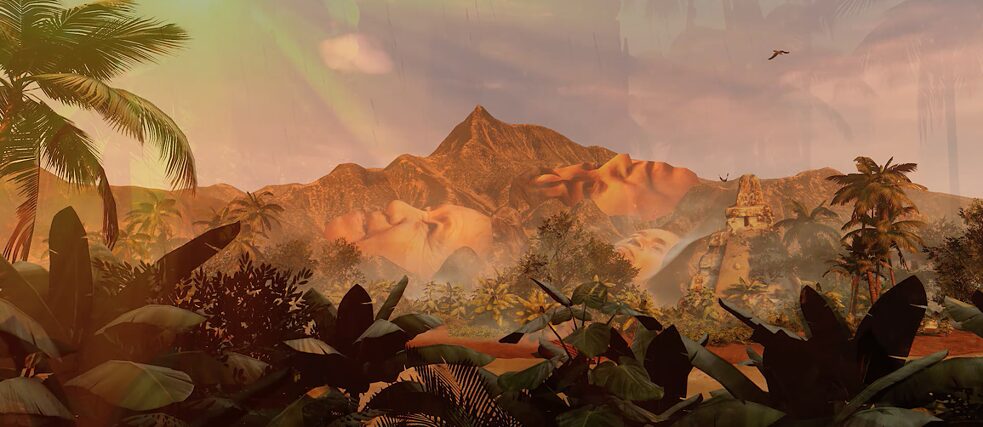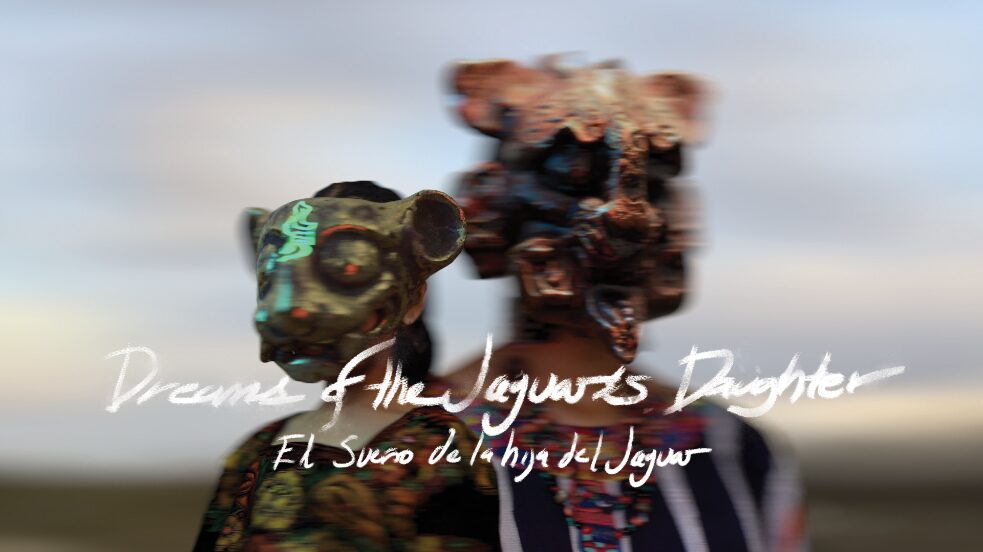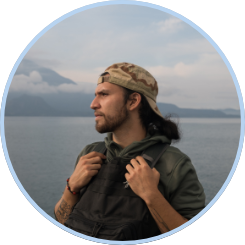A conversation with Alfredo Salazar-Caro
Looking at Earth with Fresh Eyes

Alfredo Salazar-Caro is an artist, educator, creator, and creative director of the "Digital Museum of Digital Art", a virtual reality museum. Upon invitation by the Goethe-Institut Montreal, he participated in New Nature, an immersive media and climate science exchange. After the event had wrapped up, we had the opportunity to talk to Alfredo in more detail about VR, the re-imagining of human habitats and food autonomy.
By Janna Frenzel
Alfredo Salazar-Caro, thank you for taking the time to talk more about some of the themes of New Nature and your own work. You have addressed displacement, migration and border politics as well as environmental destruction. How do you approach the intersections between these issues?
I presented my latest work, Dreams of the Jaguar’s Daughter, Chapter 1, at the Tribeca Film Festival in 2019. The work is a documentary in three parts where Achik', the spirit of a young immigrant, guides the viewers through her dreams and memories of her journey north from Central America.
It’s a very complicated set of issues that cause these mass migrations, but I think we can boil it down to a number of elements. Migration from Central America has a lot to do with the unprecedented violence there, which is directly related to the different types of US intervention such as backing and funding Contras [right-wing rebel groups] during the Reagan administration. So now there is this environment of violence that exists in these countries because of the political decisions of the past 40 years. And this is exacerbated by environmental disaster, some of which is linked to climate change while some is not, for example the eruption of Volcán de Fuego in Guatemala in 2018. The eruption displaced the entire population of the working-class town located on the edge of the mountain, with people fleeing to neighbouring towns or to Mexico or the US.
Through media we build empathy
But besides the specific geographic location and its challenges, we can see across the globe how climate change, social unrest, and war all lead to massive displacements of people, whether it be in Central America, Yemen, Somalia, or elsewhere. Environmental factors are often entangled with military conflicts and neo-imperial power strategies, and we need to address these different aspects together. This is what I am trying to do in my work.In your artistic practice, how do you choose your tools or your medium?
I have come to think of myself more as a creator and less as an artist. I don’t think that my projects need to be considered as art—it’s more important for me to use my creative energy to come up with creative solutions to the problems we are facing. The latest medium that has fascinated me is Virtual Reality. Cinema and other types of 2D-media have had tremendous influence, and we have been able to observe that looking at images evokes emotions. Through media we build empathy, fall in love with or hate someone on screen, and build societal norms and expectations around how to look, what to eat, what to wear.
Virtual Reality has a similar influence, but this influence is exponentially larger because VR gives you a different sensation of presence. You are no longer just witnessing a drama unfolding in front of you on a screen, you are inside of it. And in your subconscious, there is no difference between a simulated experience and reality. That’s why the level of influence that you are able to exert with VR is unprecedented, and why it is such an exciting and powerful medium to explore. Naturally, with the great power of VR also comes great responsibility. Already now, a lot of what the mainstream is asking for is just more hyper-masculine content that glorifies violence. But I think we also have the chance to spread content that will allow us to feel more empathy toward our fellow human beings. I see a lot of potential there.
But since we are speaking of powerful media, I am also completely fascinated by the opposite of virtual reality, the so-called “true” reality and Earth, and our relationship with it. As we strive to further tend to and develop a harmonious relationship with Earth, we get so much in return: free food and medicine, for example. This mutual exchange and interdependent relationship are of course nothing new, but I think we can look at this old medium with fresh new eyes.
 Alfredo Salazar-Caro, Poster for Dreams of the Jaguar’s Daughter, Chapter 1
| © Alfredo Salazar-Caro
Alfredo Salazar-Caro, Poster for Dreams of the Jaguar’s Daughter, Chapter 1
| © Alfredo Salazar-Caro
To make technology democratic
Currently, only a few people have had the chance to experience VR. What are your thoughts regarding its accessibility? Is it headed toward democratization, or is it set on a different path?At the moment, VR is certainly an exclusive medium. It’s a little hard to tell where it is going. Of course, there are the commercial interests of the tech elite that sees the world in a certain way and would like everybody to have a VR headset, just like any other product. But the goal of every person having a VR headset is inevitably a continuation of consumer capitalism. It would mean more mining, more deforestation, more extraction of minerals and rare earth elements, and more exploitation of people. The methods with which the materials are extracted are noxious to Earth and human lives. But we are separated so far from these processes that we don’t think about how environmental destruction and human displacement and exploitation are implicated in the production of our favorite toys.
So I don’t think that it is necessarily a good idea to support this economy, but that there are other ways to make technology democratic. Personally, I believe strongly in the practice of upcycling. There are so many devices already in circulation, and the majority of the elements necessary to make VR headsets are built into all of these devices. I would like to see legislation created that would enable upcycling for new technologies on a much bigger scale than what is happening now and curb the piling up of electronic waste. As the industry progresses, hopefully people will put in place low-carbon or zero-carbon solutions.
Besides VR, you are also involved with the Guild of Future Architects and interested in the Earthship movement. Can you describe what attracted you to these approaches of re-configuring human-nature relations from a design and built environment point of view?
The Guild of Future Architects is dedicated to radical imagination. It brings together people with different areas of expertise, similar to New Nature. We all share our creativity to envision better futures and plant seeds for these futures. Earthships are buildings inspired by Michael Reynolds, an architect who had the desire to build structures that are closer to Earth than a lot of his contemporaries who were working with computer-aided design, steel and concrete. Essentially, the Earthships address six fundamental human needs: clean water, electricity, comfortable shelter, being able to take care of your own sewage, being able to take care of your own waste, and growing your own food. This is a very fascinating concept for me, particularly when it comes to waste. They use large amounts of discarded materials such as old tires, bottles, cans as their main building material, and soil to pack it all in. It’s a great solution to address the huge amounts of waste that we create, and the question of what to do with these discarded materials. Maybe it’s not perfect, but it’s better than cutting down more trees or drilling more oil for building materials that are made of plastic.
A neighbourhood of Earthships
Given the challenges that we will be facing in the near future, I think we have no real choice but to think about our dwellings as something that needs to be as neutral as possible to the Earth and completely self-sustainable. But the idea of self-sustaining dwellings is actually very old. One can find examples of this type of design that date back to the 1300s in central Mexico, for example. The mexica were building structures that did not require any of the infrastructure that we have as so-called necessities today, and yet it delivered a lot of the same amenities such as clean water, and a sewage system where wastewater was used to water and fertilize plants. I think it is important to take this current moment to look at the past, look at examples of what our ancestors have done well, and bring it forward into this time with our new knowledge and technology. And I think Michael Reynolds moved one step in the right direction with his Earthship movement.What I’ve been doing with the Guild of Future Architects in relation to these Earthships is to imagine new human habitats that I call “the meadows.” With a group of folks, we have been trying to flesh out the idea of what it would look like if we had a neighbourhood of Earthships that was also surrounded by or built within a food forest. A food forest is an intentionally planted forest that is self-sustaining and is full of specific medicinal and edible plants. What if instead of a suburb we had these meadows that are full of food for those who dwell there and at the same time provide shelter that is carbon-neutral? That is one of my favorite thought experiments right now: working on the details of what that can look like in practice.
Building on these ideas, what is your imagined utopia for transforming human-environmental relations?
I don’t like the idea of utopia because it implies an extreme vision that will never exist. There is no perfect state of being. Our ancestors had this land as pristine as it could have ever been, but their lives were still wrecked by volcanic eruptions or hurricanes. For me, the idea of the meadows is as close as we can get to imagining a new habitat. Let’s look at where you live, no matter whether it is in upstate New York, Mexico or the Black Forest, and you can adapt these structures to fit the climate patterns of your location. You can plant and harvest the plants that are native to the area and produce food for yourself, break with the carbon-intensive and oil-dependent systems and live in a carbon-neutral way.
I often think about South America as a potential place to start with the meadows because it is a lot freer in a certain way than the US. I think in the next twenty years we will see these ideas proliferate, especially since cities are no longer the ideal places to be. The pandemic has shown very clearly that large cities are particularly vulnerable in many ways, not just in terms of the spread of infection but also in terms of our current food economy. People start panic-buying at grocery stores, and suddenly the people who arrive late have nothing to eat, and no idea of how else to feed themselves. That problem could be solved by new habitats that didn’t necessitate an extreme proximity to one another and at the same time being autonomous in terms of food supply. Of course, there are ways of retrofitting cities to accomplish these things as well. We can create food autonomy on different scales: in cities, in the meadows, in the suburbs.
In the end, building Earthships and food forests is not a difficult undertaking at all—what is difficult is the politics around it. The grip that Big Oil and Big Gas have over the way we live and operate day-to-day is incredibly strong. Until we are able to break free from this sort of “corporatocracy”, I don’t know if this utopia could exist.
Alfredo Salazar-Caro
Alfredo Salazar-Caro is a creator living and working between Mexico City, NYC, and Online. His work is an amalgamation of portraiture, installation/sculpture, documentary, video and VR/AR. Salazar-Caro is co-creator and creative director of DiMoDA, The Digital Museum of Digital Art. DiMoDA is a groundbreaking project that functions as a VR institution and exhibition platform dedicated to the development of XR Art. His work has been exhibited internationally. Exhibitions include the Tribeca Film Festival, Dreamlands at the Whitney Museum, The Wrong Biennale in São Paulo, Brazil, New Normal Beirut/Istanbul, Die Ungerahmte Welt, HeK, Basel Switzerland, Siggraph Asia, Bangkok, Thailand and 1Mes1Artista Mexico City among others. His work can be seen in publications such as Leonardo, Cultured Magazine, Vice Magazine and Creators Project.

Comments
Comment